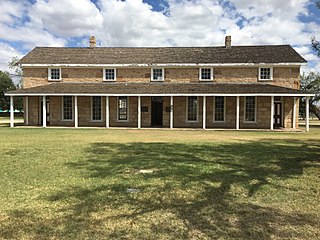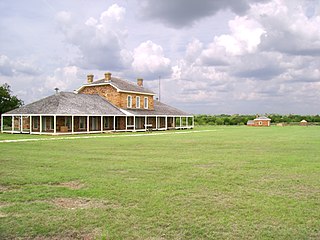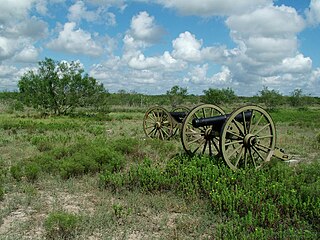 W
WThe National Museum of the Pacific War is located in Fredericksburg, Texas, the boyhood home of Fleet Admiral Chester W. Nimitz. Nimitz served as CinCPAC, commander in chief, United States Pacific Fleet, and was soon afterward named commander in chief, Pacific Ocean Areas, during World War II. The six-acre site includes the Admiral Nimitz Museum, which is housed in the old Nimitz Hotel and tells the story of Nimitz beginning with his life as a young boy through his naval career as well as the evolution of the old hotel.
 W
WThe B-36 Peacemaker Museum is a non-profit organization "Dedicated to the preservation of the rich aviation history of North Texas".
 W
WBuilding 98 at Fort D. A. Russell is the historic US army base bachelor officer quarters, officers club, and grand ballroom near Marfa, Texas; it was active from 1911 to 1946. Building 98 is Located at Fort David A. Russell's central fort complex. It is a project of the International Woman's Foundation and it is the home of the World War II German prisoners of war POW murals.
 W
WThe CAF Airpower Museum, formerly the American Airpower Heritage Museum (AAHM), is affiliate organization of the Commemorative Air Force (CAF), headquartered at Dallas Executive Airport in Dallas, Texas. The museum opened in its first building in Mercedes, Texas, in 1965 as a location to house and display World War II artifacts as they began to be donated to the CAF. Both the CAF and AAHM moved to Harlingen, Texas, in 1968. In 1990, the AAHM became a separate non-profit organization, and in 1991 both the AAHM and CAF moved to Midland, Texas. In 2015, the museum's collection was moved to Dallas in anticipation of the creation of the new CAF National Airbase.
 W
WUSS Cavalla (SS/SSK/AGSS-244), a Gato-class submarine, is a submarine of the United States Navy named for a salt water fish, best known for sinking the Japanese aircraft carrier Shōkaku.
 W
WFort Clark was a frontier fort located just off U.S. Route 90 near Brackettville, in Kinney County, Texas, United States. It later became the headquarters for the 2nd Cavalry Division. The Fort Clark Historic District was added to the National Register of Historic Places on December 6, 1979. The Commanding Officer's Quarters at Fort Clark were designated a Recorded Texas Historic Landmark in 1988. The Fort Clark Guardhouse became a Recorded Texas Historic Landmark in 1962. The Fort Clark Officers' Row Quarters were designated a Recorded Texas Historic Landmark in 1991.
 W
WThe War Memorial Museum is located at 1101–1199 Milam Street in Columbus, Texas. It is housed in an unusual building constructed in 1883: the ground floor of the town's water tower, which formerly housed its Fire Station. When the town's water system was modernized in 1926 and the water tower was no longer needed, the water tank was removed, but the building, with three foot brick walls, was so solid that dynamite, to demolish it, had no effect. It was then put up for sale. The United Daughters of the Confederacy (UDC) purchased it and used it as a meeting place. The Museum, which the UDC curates, opened in 1962.
 W
WFort Concho is a former United States Army installation and National Historic Landmark District located in San Angelo, Texas. It was established in November 1867 at the confluence of the North and South Concho Rivers, on the routes of the Butterfield Overland Mail Route and Goodnight–Loving Trail, and was an active military base for the next 22 years. Fort Concho was the principal base of the 4th Cavalry from 1867 to 1875 and then the "Buffalo Soldiers" of the 10th Cavalry from 1875 and 1882. The troops stationed at Fort Concho participated in Ranald S. Mackenzie's 1872 campaign, the Red River War in 1874, and the Victorio Campaign of 1879–1880.
 W
WFort Davis National Historic Site is a United States National Historic Site located in the unincorporated community of Fort Davis, Jeff Davis County, Texas. Located within the Davis Mountains of West Texas, the historic site was established in 1961 to protect one of the best remaining examples of a United States Army fort in the southwestern United States.
 W
WFort Duncan was a United States Army base, set up to protect the first U.S. settlement on the Rio Grande near the current town of Eagle Pass, Texas.
 W
WFort Griffin, now a Texas state historic site as Fort Griffin State Historic Site, was a US Cavalry fort established 31 July 1867 by four companies of the Sixth Cavalry, U.S. Army under the command of Lt. Col. S.D. Sturgis, in the northern part of West Texas, specifically northwestern Shackelford County, to give settlers protection from early Comanche and Kiowa raids. Originally called Camp Wilson after Henry Hamilton Wilson, a recently deceased lieutenant, it was later named for Charles Griffin, a former Civil War Union general who had commanded, as de facto military governor, the Department of Texas during the early years of Reconstruction.
 W
WFort Richardson was a United States Army installation located in present-day Jacksboro, Texas. Named in honor of Union General Israel B. Richardson, who died in the Battle of Antietam during the American Civil War, it was active from 1867 to 1878. Today, the site, with a few surviving buildings, is called Fort Richardson State Park, Historic Site and Lost Creek Reservoir State Trailway. It was designated a National Historic Landmark in 1963 for its role in securing the state's northern frontier in the post-Civil War era.
 W
WThe Fort Worth Aviation Museum is an aviation museum located next to Meacham International Airport in Fort Worth, Texas. The museum was rebranded in 2013 and was previously known as the Veterans Memorial Air Park.
 W
WThe HA. 19 is a historic Imperial Japanese Navy Type A Kō-hyōteki-class midget submarine that was part of the Japanese attack on Pearl Harbor on 7 December 1941. The submarine's crew was ordered to enter Pearl Harbor, attack the moored American warships with its two torpedoes and then scuttle her with explosives. However, the crew was unable to enter the harbor due to navigational difficulties, and the submarine ran aground and was captured by American forces.
 W
WThe Japanese Garden of Peace is a peace garden installed at the National Museum of the Pacific War in Fredericksburg, Texas.
 W
WUSS Lexington (CV/CVA/CVS/CVT/AVT-16), nicknamed "The Blue Ghost", is an Essex-class aircraft carrier built during World War II for the United States Navy. Originally intended to be named Cabot, word arrived during construction that USS Lexington (CV-2) had been lost in the Battle of the Coral Sea. The new aircraft carrier was renamed while under construction to commemorate the earlier ship.
 W
WThe Lone Star Flight Museum, located in Houston, Texas, is an aerospace museum that displays more than 24 historically significant aircraft, and many artifacts related to the history of flight. The museum's collection is rare because most of the aircraft are flyable. Located at Ellington Airport, the museum is housed on about 100,000 ft2 of property, including its own airport ramp. The museum, formerly located in Galveston, moved to Houston to avoid a repeat of the devastation suffered during Hurricane Ike.
 W
WFort Mason was established on July 6, 1851, in present-day Mason County, Texas. It was named in honor of George Thomson Mason, a United States Army second lieutenant killed in the Thornton Affair during the Mexican–American War near Brownsville, April 25, 1846. At various times from 1856 to 1861, this was the home fort for Albert Sidney Johnston, George H. Thomas, Earl Van Dorn, and Robert E. Lee. The fort was abandoned by the military in the 1870s, and restored by a group of local citizens in 1975. Visitors can tour the reproduction officers' quarters at the Fort Mason Museum.
 W
WFort McKavett State Historic Site is located in Menard County, Texas, United States. Fort McKavett was a frontier fort established as Camp on the San Saba in 1852 to protect settlers from Indian raids. The camp was renamed in honor of Captain Henry McKavett, who was killed in the Mexican–American War battle of Monterrey.
 W
WThe National Museum of the Pacific War is located in Fredericksburg, Texas, the boyhood home of Fleet Admiral Chester W. Nimitz. Nimitz served as CinCPAC, commander in chief, United States Pacific Fleet, and was soon afterward named commander in chief, Pacific Ocean Areas, during World War II. The six-acre site includes the Admiral Nimitz Museum, which is housed in the old Nimitz Hotel and tells the story of Nimitz beginning with his life as a young boy through his naval career as well as the evolution of the old hotel.
 W
WPalo Alto Battlefield National Historical Park near Brownsville, Texas is a National Park Service unit which preserves the grounds of the May 8, 1846, Battle of Palo Alto. It was the first major conflict in a border dispute that soon precipitated the Mexican–American War. The United States Army victory here made the invasion of Mexico possible. The historic site portrays the battle and the war, and its causes and consequences, from the perspectives of both the United States and Mexico.
 W
WThe Pearce Museum is a museum in Corsicana, Texas, containing two galleries, Western art and American Civil War sections. It is located in the Cook Center at Navarro College.
 W
WThe Presidio Nuestra Señora de Loreto de la Bahía, known more commonly as Presidio La Bahía, or simply La Bahía is a fort constructed by the Spanish Army that became the nucleus of the modern-day city of Goliad, Texas, United States. The current location dates to 1747.
 W
WFort Martin Scott is a restored United States Army outpost near Fredericksburg in the Texas Hill Country, United States, that was active from December 5, 1848, until April, 1853. It was part of a line of frontier forts established to protect travelers and settlers within Texas.
 W
WSilent Wings Museum, "The Legacy of The World War II Glider Pilots," is a museum in Lubbock, Texas. The museum is housed in the former tower and terminal building of Lubbock's airport during the 1950s, and 1960s.
 W
WUSS Stewart (DE–238) is an Edsall-class destroyer escort, the third United States Navy ship so named. This ship was named for Rear Admiral Charles Stewart, who commanded USS Constitution during the War of 1812. Stewart is one of only two preserved destroyer escorts in the U.S. and is the only Edsall-class vessel to be preserved. It is on display in Galveston TX as a museum ship and is open to the public.
 W
WUSS Tautog (SSN-639), a Sturgeon-class attack submarine, was the second ship of the United States Navy to be named for the Tautog, a wrasse commonly found along the Northern Atlantic coast. The submarine was in service from 17 August 1968 to 31 March 1997.
 W
WUSS Texas (BB-35) is a former United States Navy New York-class battleship. She was launched on 18 May 1912 and commissioned on 12 March 1914.
 W
WHill College is a public community college in Hillsboro, Texas. It opened its doors in 1923, one year before North Central Texas College, which is the oldest continuously-operating community college in Texas because Hill College was closed during the 1950s.
 W
WThe Texas Military Forces Museum is a history museum in Austin, Texas. It is hosted by the Texas Military Department at Camp Mabry and is part of the United States Army Historical Program.
 W
WThe U.S. Army Medical Department Museum — or AMEDD Museum — at Fort Sam Houston, San Antonio, Texas, originated as part of the Army's Field Service School at Carlisle Barracks, Pennsylvania. It moved to Fort Sam Houston in 1946. It is currently a component of the U.S. Army Medical Department Center and School.